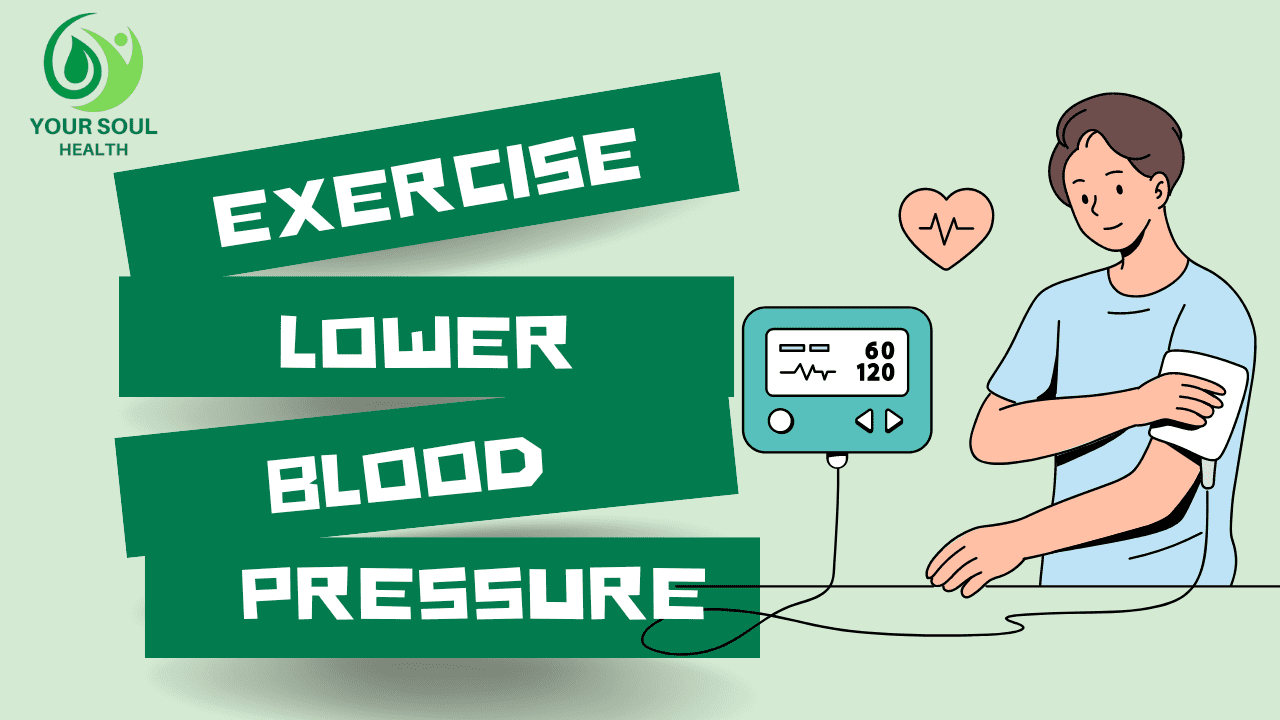Discover how does exercise lower blood pressure. Regular exercise can help lower blood pressure. It makes the heart stronger, which in turn decreases the force on the arteries, leading to lower blood pressure levels.
Exercise, especially aerobic and isometric exercises, has been shown to be effective in managing and reducing high blood pressure. According to studies, activities like planks, squats, and other isometric exercises can help control and prevent the development of high blood pressure.
In addition, aerobic activities like walking, cycling, or swimming can significantly improve heart and blood vessel health, leading to lower blood pressure. Moreover, engaging in physical activity helps not only in controlling hypertension but also in overall health management. By incorporating regular exercise into your routine, you can effectively manage and lower your blood pressure levels.
The Impact Of Exercise On Blood Pressure
Exercise has a positive impact on blood pressure by making the heart stronger and reducing the force on arteries. Isometric exercises like planks and wall squats, along with aerobic activities, are effective in lowering high blood pressure.
Understanding Blood Pressure
Blood pressure is a measurement of the force that blood applies to the artery walls during its flow through them. It is measured in millimeters of mercury (mmHg) and is represented by two numbers, systolic pressure over diastolic pressure. The systolic pressure represents the force when the heart contracts and pumps blood, while the diastolic pressure represents the force when the heart relaxes between beats.
The Role Of Exercise In Lowering Blood Pressure
Exercise plays a crucial role in managing and lowering blood pressure. Regular physical activity stimulates the heart and circulatory system, resulting in various cardiovascular benefits. When you exercise, your heart beats faster, which in turn, increases blood flow throughout your body. Over time, this increased blood flow helps to strengthen your heart and improve its efficiency.
One of the significant ways exercise lowers blood pressure is by reducing peripheral resistance. Peripheral resistance refers to the resistance that blood encounters as it travels through the arteries. When you exercise, your blood vessels expand and become more flexible, allowing blood to flow more freely. This decrease in resistance ultimately leads to a decrease in blood pressure.
Regular exercise also helps in maintaining a healthy body weight, which is essential for blood pressure control. When you engage in physical activity, you burn calories, reduce excess body weight, and decrease the overall strain on your cardiovascular system. This, in turn, helps to lower your blood pressure.
In addition to these direct effects, exercise can also help manage stress, which is a significant contributor to high blood pressure. Engaging in physical activity releases endorphins, which are known as “feel-good” hormones. These endorphins help reduce stress levels and promote a sense of well-being, ultimately leading to better blood pressure control.

Credit: www.amazon.com
Types Of Exercises For Lowering Blood Pressure
Exercise plays a vital role in managing blood pressure levels. Different types of exercises can help lower blood pressure effectively. Here are two key categories of exercises that can significantly impact blood pressure:
Aerobic Exercises
Aerobic exercises are repetitive and rhythmic movements that engage the heart, lungs, blood vessels, and muscles. These exercises are beneficial for improving overall cardiovascular health and can help reduce high blood pressure.
Isometric Exercises
Isometric exercises, also known as static exercises, involve maintaining a static position and tension on the muscle without joint movement. Studies suggest that isometric exercises such as planks and wall squats can be particularly effective in lowering blood pressure.
The Best Exercises For Lowering Blood Pressure
Regular exercise is essential for lowering high blood pressure. Isometric exercises like planks and wall squats have been shown to be highly effective. Aerobic activities are also recommended for improving heart and blood vessel health. Keeping hydrated can aid in maintaining normal blood pressure levels.
Bridges
Performing bridges can help strengthen your core and lower blood pressure by improving circulation.
Planks
Engaging in planks is an effective isometric exercise that can lower blood pressure by enhancing overall muscle tone.
Squats
Squats are a great way to improve cardiovascular health and reduce blood pressure by increasing heart strength.
Scientific Studies And Evidence
Impact of Different Types of Exercises on Blood Pressure
A British Journal of Sports Medicine study highlighted the efficacy of isometric exercises like planks and wall squats in reducing blood pressure. Isometric exercises involve static positions and muscle tension, aiding in blood pressure management.
Isometric exercises, being static, do not involve joint movement, thus exerting less strain on the heart during workouts. These exercises can contribute significantly towards lowering overall blood pressure levels.
The Relationship Between Hydration And Blood Pressure
Maintaining proper hydration is essential for controlling blood pressure. The body’s blood volume is directly influenced by its hydration levels, which, in turn, affects blood pressure. Understanding the relationship between hydration and blood pressure is essential in maintaining overall cardiovascular health.
The Role Of Hydration In Blood Pressure Regulation
Proper hydration is essential for maintaining healthy blood pressure. When the body is well-hydrated, the blood volume is adequate, which helps support normal blood pressure levels. Adequate hydration also helps the kidneys function optimally, assisting in regulating blood pressure through fluid balance. Dehydration can lead to a decrease in blood volume, causing an increase in blood pressure as the heart pumps harder to push blood through the body.
Effects Of Dehydration On Blood Pressure
Dehydration can have significant impacts on blood pressure. Dehydration causes the body’s blood volume to drop, which raises blood pressure. Additionally, dehydration can cause the blood to become more viscous, making it harder for the heart to pump, further elevating blood pressure. It is important to maintain proper hydration to support healthy blood pressure levels and overall cardiovascular function.
:max_bytes(150000):strip_icc()/VWF-What-is-Stamina-Definition-Tips-How-to-Improve-5085005-dffa0255d0254a098fd12d816aaf78b0.jpg)
Credit: www.verywellfit.com
Lifestyle Changes For Managing Blood Pressure
Managing blood pressure through lifestyle changes is a crucial aspect of overall well-being. Exercise can play a significant role in lowering blood pressure and keeping it at a healthy level. Incorporating regular physical activity and adopting additional strategies can lead to favourable outcomes in blood pressure management.
Incorporating Exercises Into Daily Routine
Integrating exercise into your daily routine can have a positive impact on blood pressure levels. Consider starting with brisk walking, cycling, or swimming, as these are effective aerobic exercises. Engaging in these activities for a minimum of 30 minutes on most days of the week can yield significant improvements in blood pressure.
Additional Strategies For Blood Pressure Management
In addition to regular exercise, certain lifestyle modifications can further aid in managing blood pressure. Limiting sodium intake, consuming a balanced diet rich in fruits and vegetables, and maintaining a healthy weight is vital. Furthermore, managing stress through relaxation techniques such as meditation or yoga can contribute to overall blood pressure control.
Expert Recommendations And Guidelines
When it comes to managing high blood pressure, exercise has been proven to be an effective and drug-free approach. Medical professionals have offered their expert recommendations and guidelines on the type and amount of exercise needed to lower blood pressure and improve overall heart health.
Recommendations From Medical Professionals
According to medical professionals, aerobic exercises are highly recommended for individuals with high blood pressure. These exercises involve repetitive and rhythmic movements that engage the heart, lungs, blood vessels, and muscles. Examples of aerobic exercises include brisk walking, jogging, swimming, and cycling. Every week, try to get in at least 150 minutes of moderate-to-intense aerobic exercise or 75 minutes of vigorous exercise.
In addition to aerobic exercises, strength training exercises are also beneficial for lowering blood pressure. These exercises involve contracting muscles against resistance, such as lifting weights or using resistance bands. Aim for two or more days per week of strength training exercises that target all major muscle groups.
Guidelines For Exercise And Blood Pressure Management
When engaging in exercise to lower blood pressure, it is important to follow these guidelines:
- Start slow: If you’re new to exercise or have been inactive for a while, start with low-intensity activities and gradually increase the intensity over time. This helps prevent any sudden spikes in blood pressure.
- Monitor your heart rate: During exercise, monitor your heart rate to ensure it stays within a safe and appropriate range. To find out what your ideal heart rate range is, speak with your healthcare professional.
- Stay consistent: Regular exercise is key to maintaining healthy blood pressure levels. Most days of the week, try to get in at least 30 minutes of exercise.
- Stay hydrated: Drinking water before, during, and after exercise helps maintain proper hydration levels, which can support blood pressure regulation.
- Listen to your body: Pay attention to how your body responds to exercise. If you experience any discomfort or unusual symptoms, consult with your healthcare provider.
By following these expert recommendations and guidelines, individuals can effectively lower their blood pressure through regular exercise. Remember to consult with a healthcare provider before starting any new exercise program, especially if you have pre-existing medical conditions or are on medication for high blood pressure.
Real-life Testimonials And Success Stories
Personal Experiences With Lowering Blood Pressure Through Exercise
Exercise has transformed the lives of many individuals struggling with high blood pressure.
- Melissa, 45: “I’ve noticed a considerable reduction in my blood pressure since I started exercising regularly.”
- David, 52: “My blood pressure dropped and my energy level increased while I exercised.”
- Sarah, 37: “Although at first I wasn’t convinced, exercise has been essential to controlling my blood pressure.”
Impact Of Exercise On Overall Health And Well-being
Engaging in physical activity not only reduces blood pressure but also enhances overall health.
- Improved Cardiovascular Health: Exercise strengthens the heart, leading to better blood flow.
- Enhanced Mental Well-being: Physical activity releases endorphins, promoting a sense of well-being.
- Weight Management: Regular exercise aids in weight loss, reducing strain on the heart.
Credit: thecarltoddclinic.com
Frequently Asked Questions On Does Exercise Lower Blood Pressure
How Quickly Does Exercise Lower Blood Pressure?
Exercise can lower blood pressure quickly by strengthening the heart, and reducing the force on the arteries. Aerobic activities are recommended, avoid activities that strain the heart. Isometric exercises like planks and wall squats may also be effective. Drinking water can help normalize blood pressure, and dehydration can increase it.
What Is The Best Exercise For Lowering Blood Pressure?
The best exercises for lowering blood pressure are isometric exercises like planks and wall squats. Isometric exercises involve static positions without joint movement, proven effective in reducing blood pressure.
Should I Exercise If My BP is High?
High blood pressure patients can exercise, focusing on aerobic activities to benefit the heart and blood vessels. Stay away from activities that put a burden on your heart. Aerobic exercises involve rhythmic movements that engage the heart, lungs, blood vessels, and muscles effectively.
Can Drinking Water Lower Blood Pressure?
Drinking water can help lower blood pressure and normalize it. It is not a treatment for high blood pressure, but staying hydrated can support healthier blood pressure levels.
Conclusion
Exercise has been proven to be an effective, drug-free approach to lowering high blood pressure. Regular exercise strengthens the heart, allowing it to pump more blood with less effort and reducing the force on the arteries. Lower blood pressure is the outcome of this.
Isometric exercises, such as planks and wall squats, have been found to be particularly effective in lowering blood pressure. Incorporating aerobic activities into your routine can also help improve cardiovascular health. Remember to consult with a healthcare professional before starting any exercise program to ensure it is safe for you.


1 thought on “Does Exercise Lower Blood Pressure?”